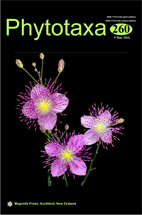Abstract
The new species Carex roalsoniana (Cyperaceae) from Ecuador and Peru (northern South America) is here described and illustrated. It is related to C. subandrogyna, a species that has been placed in section Schiedeanae. An additional incertae sedis species, Carex lepida from Ecuador, may also be related to them. Section Schiedanae is a morphologically well-defined group previously known from southern North America (southern USA and Mexico), and southern South America (northern Argentina and southern Bolivia). The new species presents very clear-cut characters that distinguish it from all the other members of the section. Specifically, C. roalsoniana and C. subandrogyna differ in utricle morphology (3.6–4.1 mm long, with a beak 0.5–1.2 mm in C. roalsoniana vs. 2.4–2.9 mm long, with a beak up to 0.3 mm long or beakless in C. subandrogyna) and leaves (up to 3–4 mm wide, stiff, in C. roalsoniana vs. up to 5.6–7.5 mm wide, very soft in C. subandrogyna). Carex lepida is easily distinguished from C. roalsoniana and C. subandrogyna because its habit (rhizomes elongated vs. rhizomes densely caespitose) and number of stigmas (two vs. three). The glabrous nerveless utricles of the three South American species distinguish them from the North American species of the section, which have scabrid to hispidulous, conspicuously nerved utricles. The formal ascription of C. lepida among the South American members of section Schiedeanae is also discussed. A brief key to distinguish C. lepida and C. roalsoniana from the other species of the section and the co-occurring species is provided.

